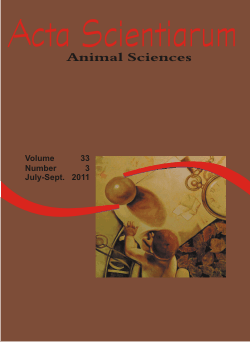<b>Using the same CIDR up to three times for estrus synchronization and artificial insemination in dairy goats</b> - doi: 10.4025/actascianimsci.v33i3.10120
Keywords:
hormone treatment, small ruminant, Tropical region, vaginal device
Abstract
The objective of this study was to evaluate the effectiveness of reusing a controlled internal drug release (CIDR) device for up to three times in the reproductive performance of dairy goats raised in the semi-arid zone of northeastern Brazil. Forty-five goats were allocated into three hormone treatments, as follows: CIDR1x, treated with new CIDR during nine days. Two days prior to device removal, injections of 75 µg d-cloprostenol and 300 IU equine chorionic gonadotropin (eCG) were administrated. For the other treatments, the same hormone protocol was used, differing only by the use of the same CIDR for a second time in CIDR2x and for a third time in CIDR3x. The interval from device removal to the onset of estrus (13.3 ± 1.1h vs. 13.8 ± 2.6h vs. 13.3 ± 1.4h), as well as estrus duration (33.6 ± 7.3h vs. 29.6 ± 3.2h vs. 32.8 ± 4.5h), did not differ (p > 0.05) among groups CIDR1x, CIDR2x and CIDR3x, respectively. All synchronized females were found to be in estrus. The overall fertility and prolificacy after artificial insemination were 82.2% and 1.9 kids, respectively, without significant difference (p > 0.05) among treatments. The use of the same CIDR for up to three times was effective using 9-day estrus synchronization protocols in dairy goats.Downloads
Download data is not yet available.
Published
2011-03-21
How to Cite
Nogueira, D. M., Lopes Júnior, E. S., Peixoto, R. M. de, Christilis, M., Martins, S. R., & Monte, A. P. O. do. (2011). <b>Using the same CIDR up to three times for estrus synchronization and artificial insemination in dairy goats</b> - doi: 10.4025/actascianimsci.v33i3.10120. Acta Scientiarum. Animal Sciences, 33(3), 321-325. https://doi.org/10.4025/actascianimsci.v33i3.10120
Issue
Section
Animal Breeding and Reproduction
DECLARATION OF ORIGINALITY AND COPYRIGHTS
- I Declare that current article is original and has not been submitted for publication, in part or in whole, to any other national or international journal.
The copyrights belong exclusively to the authors. Published content is licensed under Creative Commons Attribution 4.0 (CC BY 4.0) guidelines, which allows sharing (copy and distribution of the material in any medium or format) and adaptation (remix, transform, and build upon the material) for any purpose, even commercially, under the terms of attribution.
Read this link for further information on how to use CC BY 4.0 properly.
0.9
2019CiteScore
29th percentile
Powered by 








































